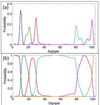The discovery of processing stages: Extension of Sternberg's method
- PMID: 27135600
- PMCID: PMC5033670
- DOI: 10.1037/rev0000030
The discovery of processing stages: Extension of Sternberg's method
Abstract
We introduce a method for measuring the number and durations of processing stages from the electroencephalographic signal and apply it to the study of associative recognition. Using an extension of past research that combines multivariate pattern analysis with hidden semi-Markov models, the approach identifies on a trial-by-trial basis where brief sinusoidal peaks (called bumps) are added to the ongoing electroencephalographic signal. We propose that these bumps mark the onset of critical cognitive stages in processing. The results of the analysis can be used to guide the development of detailed process models. Applied to the associative recognition task, the hidden semi-Markov models multivariate pattern analysis method indicates that the effects of associative strength and probe type are localized to a memory retrieval stage and a decision stage. This is in line with a previously developed the adaptive control of thought-rational process model, called ACT-R, of the task. As a test of the generalization of our method we also apply it to a data set on the Sternberg working memory task collected by Jacobs, Hwang, Curran, and Kahana (2006). The analysis generalizes robustly, and localizes the typical set size effect in a late comparison/decision stage. In addition to providing information about the number and durations of stages in associative recognition, our analysis sheds light on the event-related potential components implicated in the study of recognition memory. (PsycINFO Database Record
(c) 2016 APA, all rights reserved).
Figures




















References
-
- Assecondi S, Bianchi AM, Hallez H, Staelens S, Casarotto S, Lemahieu I, Chiarenza GA. Automated identification of ERP peaks through Dynamic Time Warping: An application to developmental dyslexia. Clinical Neurophysiology. 2009;120(10):1819–1827. - PubMed
-
- Anderson JR. How Can the Human Mind Occur in the Physical Universe? New York: Oxford University Press; 2007.
-
- Anderson JR, Carter CS, Fincham JM, Qin Y, Ravizza SM, Rosenberg-Lee M. Using fMRI to test models of complex cognition. Cognitive Science. 2008;32(8):1323–1348. - PubMed
-
- Anderson JR, Fincham JM. Discovering the sequential structure of thought. Cognitive Science. 2014a;38(2):322–352. - PubMed
MeSH terms
Grants and funding
LinkOut - more resources
Full Text Sources
Other Literature Sources
Medical
Research Materials
Miscellaneous

